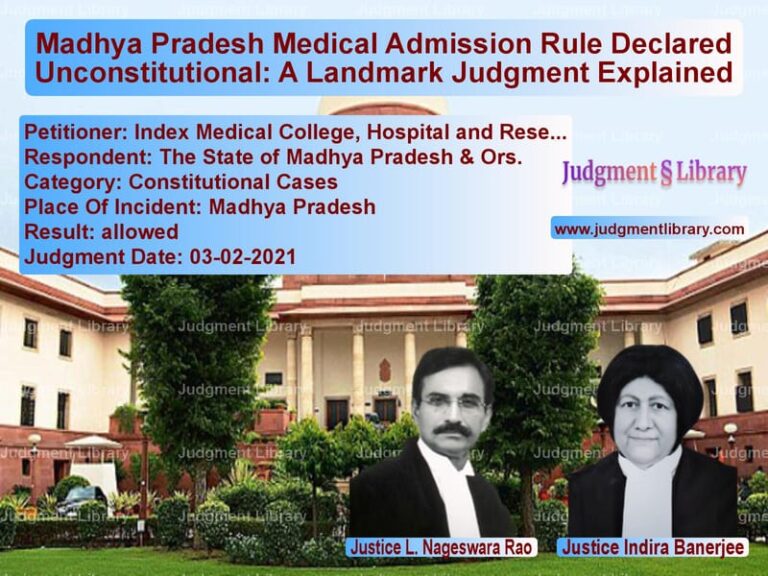Supreme Court Acquits Three in Murder Case Due to Lack of Evidence
The Supreme Court of India, in Nusrat Parween vs. State of Jharkhand, has overturned the conviction of three accused individuals in a murder case due to lack of conclusive evidence. The judgment, delivered by Dipankar Datta and Sandeep Mehta, found that the prosecution failed to establish a continuous chain of circumstantial evidence to prove the guilt of the accused.
Background of the Case
The case involved the alleged murder of Hamida Parween in Jamshedpur, Jharkhand, on March 11, 1997. The prosecution claimed that the accused, including Nusrat Parween, Ahmad Khan, and Abdul Rahman Khan, were responsible for her death due to an ongoing property dispute over Holding No. 13.
Initially, the First Additional Sessions Judge, Jamshedpur, convicted the accused under Section 302 IPC and sentenced them to life imprisonment. The High Court of Jharkhand upheld this decision. However, upon appeal, the Supreme Court reviewed the evidence and determined that the case was built on circumstantial evidence with critical gaps.
Legal Issues Considered
- Was there sufficient evidence to prove that the accused were present at the scene of the crime?
- Did the prosecution establish a clear motive for the murder?
- Was the ‘last seen’ theory applicable in this case?
- Was the burden of proof wrongly shifted to the accused?
Arguments by the Appellants
The accused, represented by Senior Advocate Rajeev Gupta, argued:
- The case was based entirely on circumstantial evidence with no direct eyewitness testimony.
- The prosecution failed to establish motive beyond a general property dispute.
- There was no credible evidence that they were present at the crime scene when the murder occurred.
- The trial court and High Court erred in applying Section 106 of the Indian Evidence Act (burden of proof) to shift the onus onto the accused.
Arguments by the State
The prosecution, represented by Standing Counsel Ravi Verma, countered:
- The accused had a clear motive—to gain full ownership of Holding No. 13.
- Witnesses confirmed that a quarrel occurred between the accused and the victim on the morning of the incident.
- After the quarrel, the accused were last seen at the house before disappearing.
- When the house was opened, the victim’s body was discovered inside, locked from the outside.
Supreme Court’s Observations
On Motive
The Court stated:
“Ongoing squabbles between close relatives residing under one roof are not unusual and cannot, by themselves, establish motive for murder. The prosecution failed to prove that the accused had an immediate and compelling reason to kill the deceased.”
On the ‘Last Seen’ Theory
The Court noted:
“The prosecution did not produce any credible witness who saw the accused at the crime scene just before the incident. Mere presence in a shared household does not establish guilt.”
On Burden of Proof
The Court criticized the High Court for wrongly applying Section 106 of the Indian Evidence Act:
“In cases based on circumstantial evidence, the burden remains on the prosecution to establish guilt beyond reasonable doubt. The accused cannot be convicted merely because they failed to explain certain circumstances.”
On Procedural Lapses
The Court identified procedural flaws, including:
- The failure to examine key witnesses, such as the victim’s younger son and daughter.
- The lack of forensic evidence linking the accused to the crime.
- Inconsistent statements by witnesses.
Final Verdict
The Supreme Court quashed the convictions and issued the following directives:
- The convictions were overturned due to lack of evidence.
- Nusrat Parween, Ahmad Khan, and Abdul Rahman Khan were acquitted.
- If Abdul Rahman Khan was still in custody, he was to be released immediately.
- The High Court and trial court’s judgments were set aside.
Impact of the Judgment
This ruling has significant implications:
- Reinforces the principle that circumstantial evidence must be conclusive.
- Prevents wrongful convictions based on weak evidence.
- Clarifies the application of burden of proof in criminal cases.
- Highlights the importance of procedural fairness.
The judgment sets a strong precedent in ensuring that criminal convictions are based on solid and indisputable evidence, reinforcing the principles of justice.
Petitioner Name: Nusrat Parween.Respondent Name: State of Jharkhand.Judgment By: Justice Dipankar Datta, Justice Sandeep Mehta.Place Of Incident: Jamshedpur, Jharkhand.Judgment Date: 10-12-2024.
Don’t miss out on the full details! Download the complete judgment in PDF format below and gain valuable insights instantly!
Download Judgment: nusrat-parween-vs-state-of-jharkhand-supreme-court-of-india-judgment-dated-10-12-2024.pdf
Directly Download Judgment: Directly download this Judgment
See all petitions in Murder Cases
See all petitions in Bail and Anticipatory Bail
See all petitions in SC/ST Act Case
See all petitions in Custodial Deaths and Police Misconduct
See all petitions in Judgment by Dipankar Datta
See all petitions in Judgment by Sandeep Mehta
See all petitions in allowed
See all petitions in Quashed
See all petitions in supreme court of India judgments December 2024
See all petitions in 2024 judgments
See all posts in Criminal Cases Category
See all allowed petitions in Criminal Cases Category
See all Dismissed petitions in Criminal Cases Category
See all partially allowed petitions in Criminal Cases Category







